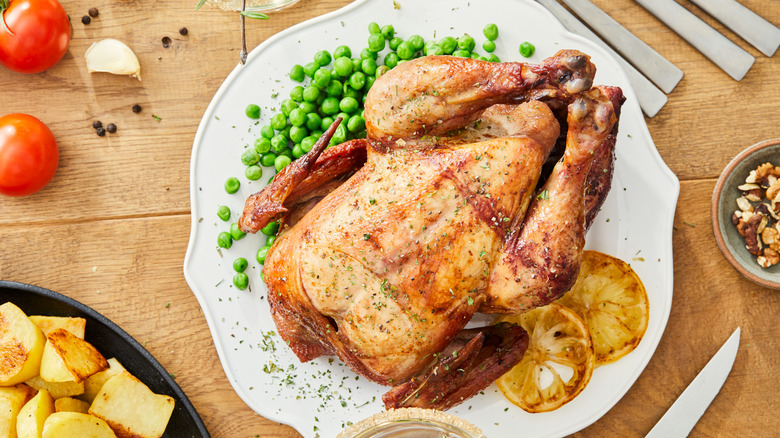Ina Garten Explains Why You Can Keep Things Simple When Trussing Chicken
Whole chickens are traditionally tied together with kitchen twine to ensure the legs and wings sit snugly up against the main body of the bird before they're roasted. Known as trussing, this technique, which involves sliding twine under the fleshy protruding bit at the base of the chook (known as the pope's nose) and around the legs, helps it to keep its shape and cook evenly. The twine is then wrapped across the leg joints in a figure of eight before it's taken to the back of the bird to tie in the wings. However, Ina Garten keeps it far simpler with her hassle-free method for trussing a classic roast chicken.
According to her recipe for Engagement Chicken, which she shared on her Food Network series, "Barefoot Contessa," you don't need to tie your chook in a complicated way; simply tie the legs together in a single knot to prevent them from fanning out and baking unevenly. Then tuck the wings under the bird to keep it in formation.
Of her method, Garten said, "There are lots of ways to truss a chicken but I hate when it looks like it's in bondage. All you have to do is tie the legs together. Trussing is really just about making sure the chicken roasts evenly. If the legs are out, they are not going to roast at the same time as the rest of the body of the chicken."
How to truss a chicken with kitchen twine in one move
While the classic trussing method creates a compact package, it can be tricky to execute if you haven't done it before, are squeamish about handling raw chicken, or don't know how to make a slip-knot. In contrast, Garten's effortless technique is quicker because there are only a couple of moves involved. She ties the legs together with kitchen string, so they sit on top of the chicken, using a regular, uncomplicated knot. Then, instead of taking the twine under the bird to truss the wings securely, she skips this step altogether in favor of tucking them under the base. According to Garten, this is sufficient to secure the legs and wings as they bake.
Garten also preps her chicken by patting it dry with a paper towel before drizzling it with olive oil, scattering over salt and pepper, and filling the cavity with lemon and garlic. The idea is that the aromatics gather at the base of the pan along with the umami juices from the chicken, creating a lip-smacking jus. A splash of white wine, chicken stock, and a sprinkle of flour is added to this jus to make a flavorful sauce while the roast chicken rests.
If you don't have any twine, never fear! You can truss a chicken without string by making incisions in the flesh, crossing the legs over, and tucking them inside the slashed pockets.

